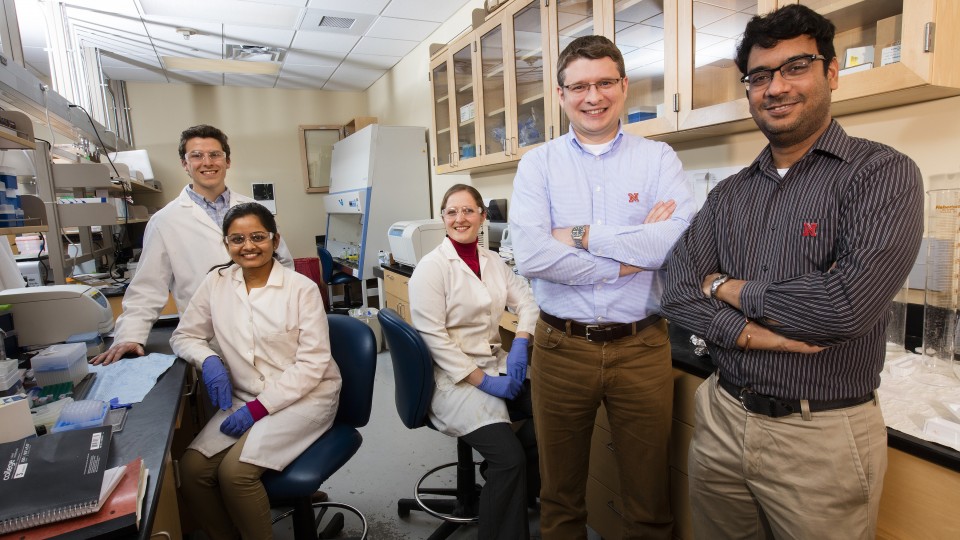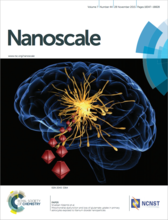· 4 min read
Researchers show modest levels of nanoparticle may harm brain cells

Even moderate concentrations of a nanoparticle used to whiten certain foods, milk and toothpaste could potentially compromise the brain’s most numerous cells, according to a new study from the University of Nebraska-Lincoln.
The researchers examined how three types of titanium dioxide nanoparticles, the world’s second-most abundant nanomaterial, affected the functioning of astrocyte cells. Astrocytes help regulate the exchange of signal-carrying neurotransmitters in the brain while also supplying energy to the neurons that process those signals, among many other functions.
The team exposed rat-derived astrocyte cells to nanoparticle concentrations well below the extreme levels that have been shown to kill brain cells but are rarely encountered by humans. At the study’s highest concentration of 100 parts per million, or PPM, two of the nanoparticle types still killed nearly two-thirds of the astrocytes within a day. That mortality rate fell to between half and one-third of cells at 50 PPM, settling to about one-quarter at 25 PPM.
Yet the researchers found evidence that even surviving cells are severely impaired by exposure to titanium dioxide nanoparticles. Astrocytes normally take in and process a neurotransmitter called glutamate that plays wide-ranging roles in cognition, memory and learning, along with the formation, migration and maintenance of other cells.
When allowed to accumulate outside cells, however, glutamate becomes a potent toxin that kills neurons and may increase the risk of neurodegenerative diseases such as Alzheimer’s and Parkinson’s. The study reported that one of the nanoparticle types reduced the astrocytes’ uptake of glutamate by 31 percent at concentrations of just 25 PPM. Another type decreased that uptake by 45 percent at 50 PPM.
The team further discovered that the nanoparticles upset the intricate balance of protein dynamics occurring within astrocytes’ mitochondria, the cellular organelles that help regulate energy production and contribute to signaling among cells. Titanium dioxide exposure also led to other signs of mitochondrial distress, breaking apart a significant proportion of the mitochondrial network at 100 PPM.
“These events are oftentimes predecessors of cell death,” said Oleh Khalimonchuk, a UNL assistant professor of biochemistry who co-authored the study. “Usually, people are looking at those ultimate consequences, but what happens before matters just as much. Those little damages add up over time. Ultimately, they’re going to cause a major problem.”
Khalimonchuk and fellow author Srivatsan Kidambi, assistant professor of chemical and biomolecular engineering, cautioned that more research is needed to determine whether titanium dioxide nanoparticles can avoid digestion and cross the blood-brain barrier that blocks the passage of many substances.
However, the researchers cited previous studies that have discovered these nanoparticles in the brain tissue of animals with similar blood-brain barriers. The concentrations of nanoparticles found in those specimens served as a reference point for the levels examined in the new study.
“There’s evidence building up now that some of these particles can actually cross the (blood-brain) barrier,” Khalimonchuk said. “Few molecules seem to be able to do so, but it turns out that there are certain sites in the brain where you can get this exposure.”
Kidambi said the team hopes the study will help facilitate further research on the presence of nanoparticles in consumer and industrial products.
“We’re hoping that this study will get some discussion going, because these nanoparticles have not been regulated,” said Kidambi, who also holds a courtesy appointment with the University of Nebraska Medical Center. “If you think about anything white – milk, chewing gum, toothpaste, powdered sugar – all these have nanoparticles in them.
“We’ve found that some nanoparticles are safe and some are not, so we are not saying that all of them are bad. Our reasoning is that … we need to have a classification of ‘safe’ versus ‘not safe,’ along with concentration thresholds (for each type). It’s about figuring out how the different forms affect the biology of cells.”
The study was featured on the Nov. 28 cover of Nanoscale, a journal published by the Royal Society of Chemistry. It was co-authored by Christina Wilson, Vaishaali Natarajan and Stephen Hayward, UNL doctoral students in chemical and biomolecular engineering.
The team’s research was funded in part by the National Institutes of Health under grant numbers 1T32GM107001-01A1, P30GM103335 and 1R01GM108975.








